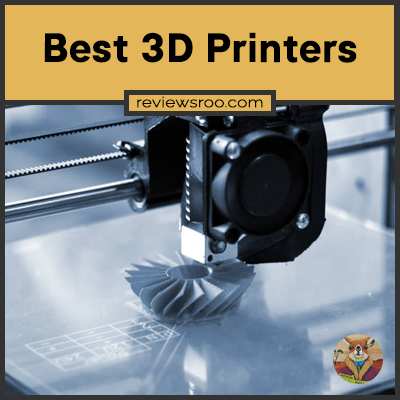Best 3D Printers
3D printing is revolutionizing the way we create objects. From medical devices to automobiles, 3D printers are transforming the way things are made. But which ones are the best? We’ll take a look at some of the top 3D printers on the market today.

3D printing has become more accessible than ever before. With advances in technology, it’s easier than ever to find a printer that fits your needs and budget. Whether you’re an experienced maker or just getting started, there’s a perfect machine for you.
We’ve looked through the latest models to find the best 3D printers available right now. Read on to discover our top picks for 2021 and get ready to make something amazing!
Overview Of 3d Printer Types
3D printers are now a popular tool for hobbyists and professionals alike. They come in various sizes, shapes, and capabilities. Let’s take a look at the different types of 3D printers out there. Fused Deposition Modeling (FDM) is the most common type of 3D printer–it uses plastic filament heated up and deposited to create an object.
Then there’s Stereolithography (SLA), which uses a laser to transform liquid resin into solid parts. Selective Laser Sintering (SLS) is another option, using high-powered lasers to fuse particles together in precise patterns. Lastly, Polyjet technology prints with photopolymer resin, creating smooth surfaces and fine details that other methods can’t match.
These are the four main types of 3D printers available today–each one offers unique advantages depending on the project needs. While FDM is great for prototypes and small production runs, SLA excels at complex geometries with intricate details. And SLS is ideal for printing large parts quickly while still maintaining accuracy in their design. Polyjet technology is best suited for very precise items that require a smooth finish and sharp edges.
Advantages Of 3d Printing
Using 3D printing is like a box of chocolates – you never know what you’re going to get. Here are the three main advantages of 3D printing:
- Time efficiency
- Cost effectiveness
- Design flexibility.
No matter the project, 3D printing can save time and money. Parts that used to take days to print can now be done in hours without sacrificing accuracy. It also costs less than traditional methods due to the lack of material waste or labor costs. Plus, it offers far more design flexibility with complex geometries and specialized parts being possible.
3D printing lets creators explore new designs and build unique objects faster than ever before. Its versatility allows for quick prototyping as well as production of end products, giving businesses the freedom to quickly iterate on ideas and get feedback from customers earlier in the process. This ability makes it one of the most powerful tools available today for rapid product development and iteration. Transitioning seamlessly into the next section, there are several factors that need to be considered when selecting a 3D printer for a particular project or application.
Factors To Consider When Selecting A 3d Printer
Imagine walking into a store, filled with all sorts of 3D printers. You stand there, feeling overwhelmed and unsure of which one to choose. With so many options, it’s important to consider certain factors before making your purchase.
When selecting a 3D printer, you should think about its print volume. This refers to the size of the object you can create with the printer. If you plan on printing larger pieces, make sure that the machine you choose has enough space for it. Additionally, consider the speed and accuracy of the printer. It’s helpful to look into how long it takes for each layer to be printed and if the printer is precise enough for your needs.
Lastly, check out the filament options available. Different filaments have different properties; some are more durable or flexible than others. Knowing what type of material you need will help you pick out a suitable machine that can handle it.
Doing research beforehand will save you time and money in the long run when picking a 3D printer that suits your needs best.
Evaluating Print Quality
According to an industry survey, 80% of consumers have stated the print quality of their 3d printing projects is the most important factor in their decision-making process. It’s no wonder, then, that evaluating print quality should be a priority when searching for the best 3D printer.
The first step is understanding what factors influence print quality. These include build plate size and quality, filament compatibility and availability, and nozzle diameter. Additionally, you’ll want to evaluate the resolution of your prints; this is measured in microns and determines how fine or coarse the details will be on your project.
The lower the number (50–100 microns), the better the resolution will be. You’ll also need to consider how quickly your printer can produce a project; this is called its speed rating and is measured in millimeters per second (mm/s). Lastly, it’s essential to research what materials you can use with your printer; many 3D printers are limited to certain types of filaments due to their compatibility issues.
Once you’ve done your research into these elements, it’s time to compare different models and brands side-by-side. This will help you determine which 3D printer offers the best overall value for money by comparing price, features, and print quality between all options available on the market.
Comparing Price And Features Of The Best 3d Printers
For those who have been dreaming of 3D printing, the sheer range of options can seem overwhelming. The journey starts with comparing the price and features of different machines. Imagine how exciting it would be to buy a 3D printer that fits your budget and meets all your needs! To help narrow down your choices, here’s a quick guide:
- Price: Look for 3D printers within your budget, but be sure to consider what you get for the money. Are extra features included? Check reviews to make sure each model is reliable.
- Quality: Make sure print quality is good enough for your projects. Is the resolution sufficient? Does the printer have good accuracy?
- Features: Look for features that will make printing easier and more fun. Can the machine handle multiple materials? Does it have a large build area? What safety features are included?
Doing research can be tedious but essential in finding the right 3D printer for you. Take notes and compare models to find one that suits both your budget and requirements. Soon enough, you’ll be ready to take on new projects with confidence!
Understanding Safety And Maintenance Requirements
Safety and maintenance are like the brakes on a car. They keep you from going too far, too fast. Just like a driver needs to pay attention to the brakes of their car, so does an owner of a 3d printer need to pay attention to safety and maintenance.
It is necessary to take certain precautions when dealing with 3d printers. Firstly, always make sure that the machine is in an isolated area with proper ventilation and no combustible materials nearby. Secondly, ensure that all parts are firmly secured before beginning any prints. Thirdly, never leave a running printer unattended and unplug it if it will not be used for an extended amount of time. Fourthly, use caution when handling heated components such as extruders and print beds. Finally, clean the printer regularly with compressed air or a vacuum cleaner to remove dust particles that could cause damage to components or interfere with printing accuracy.
Attention must also be paid to maintenance requirements of 3d printers. Regularly change out filaments or spools as needed and check for jams or clogs in the nozzle or other components that can affect print quality over time. Make sure that belts are properly tensioned in order for motors to run smoothly and efficiently during printing operations. Replace worn parts as soon as possible so that performance does not suffer due to suboptimal conditions. Lastly, inspect all electrical connections for wear or damage periodically, making repairs as necessary for safe operation of the device.
With these important points in mind, we can move forward into discussing the pros and cons of different 3d printer brands .
Discussing The Pros And Cons Of Different 3d Printer Brands
Shopping for a 3D printer can be daunting. With so many brands and models on the market, it’s difficult to know what features to prioritize. That’s why it’s important to compare the pros and cons of different 3D printer brands before making a decision.
Take Ultimaker, for example. It’s one of the most popular 3D printer models on the market today, renowned for producing high-quality prints with minimal time and effort. But while its user-friendly design is ideal for beginners, it comes with a hefty price tag that may not be suitable for those on a budget.
The same goes for any other brand you may be considering. It’s important to weigh up all the factors before investing in a 3D printer—from speed and accuracy to affordability and ease of use—to make sure you’re getting your money’s worth. Once you’ve found the perfect fit for your needs, you’ll be ready to explore the latest 3D printing technologies and get started on your projects.
Exploring The Latest 3d Printer Technologies
The world of 3D printing is ever-evolving and the latest technologies are no exception. It’s like a gust of wind blowing through the industry, shaking up established conventions and presenting new possibilities. Think of it as a giant ship, speeding towards an unknown horizon with the potential to unlock undiscovered frontiers.
Exploring these technologies requires a keen eye and an open mind. We need to consider questions like what components make up a 3D printer? What kind of materials can be used? How efficient are they? With answers in hand, we can begin to understand how these machines work and their many benefits for businesses and individuals alike.
Examining The Different Types Of 3d Printing Materials
Printing progress has been paramount in modern manufacturing. Pioneering printers are pushing the possibilities of plastic, and exploring every element of 3D printing materials. Examining these different types is essential for getting the most out of 3D technology.
From filaments to foams, there are a plethora of materials that can be used in 3D printing. Each material has its own unique properties, from strength and flexibility to resistance and durability. The choice of material can affect the success or failure of an entire project. It’s important to understand which type of material is best suited for the task at hand before selecting one to use in a 3D printer. With the right information and knowledge, it’s possible to find the perfect combination for any application.
Taking into account these different elements is just the beginning when it comes to unlocking the potential of 3D printing technology. Looking ahead, we’ll explore how this powerful tool can be used to create functional parts and objects like never before.
Exploring The Potential Of 3d Printing In The Future
3D printing is an exciting, rapidly-growing technology. Its potential has not gone unnoticed, and many experts believe that it could revolutionize many industries. As such, exploring the potential of 3d printing in the future is a must:
- It could lead to a surge in customizable products for consumers. From custom phone cases to engineered food, 3d printing has the potential to change how we buy and consume items.
- It could drastically reduce costs for manufacturers and businesses. By cutting out traditional production methods and utilizing 3d printing, manufacturers could see huge savings on labor and materials costs.
- It could reduce our environmental footprint. With 3d printing techniques such as additive manufacturing, we no longer have to worry about waste from traditional production methods – only using the materials necessary for each product can go a long way towards helping protect our planet.
The possibilities with 3d printing are seemingly endless – from new medical technologies to advances in aerospace engineering – it’s clear that this technology will play an important role in our lives going forward. We are just beginning to scratch the surface of its potential; who knows what wonders await us?
Frequently Asked Questions
How Long Does It Take To Learn How To Use A 3d Printer?
It’s a brave new world – 3D printing has revolutionized the way we create, and it’s no wonder that more and more people are eager to learn. But how long does it take to get up to speed? In this article, we’ll explore just that.
Learning the ins and outs of a 3D printer is a process. It can take anywhere from one hour for a casual user to several weeks for a professional. First off, you’ll need to familiarize yourself with all the parts of the printer, which includes reading up on the software you’ll be using. Then comes understanding what settings are most appropriate for your project and familiarizing yourself with how to make adjustments as needed. And lastly, you’ll need plenty of practice – understanding what works best takes time and experience.
It may seem daunting at first, but once you start getting comfortable with the technology you’ll be amazed at what you can do! With enough effort and dedication, anyone can become an expert 3D printer in no time. So don’t be afraid to jump right in – the possibilities are truly endless!
What Is The Average Cost Of A 3d Printer?
Do you want to join the 3D printing revolution? Well, it all starts with knowing the average cost of a 3D printer. Like ‘the old saying’ goes, knowledge is power! To find out the average cost of a 3D printer, you’ll need to do some research. Prices range widely depending on what type and size of printer you’re looking for. Smaller desktop printers can be as little as $200 while industrial-level models can exceed $5,000.
When considering the price of your 3D printer, it’s important to look at the features available and determine how much you’re willing to pay for them. It’s also worth taking into account any additional costs like maintenance and replacement parts which may be necessary over time.
TIP: Before making a purchase, read online reviews from other users who have already purchased 3D printers and ask questions about their experience. This will help give you an idea of what to expect when you make your decision.
How Difficult Is It To Maintain A 3d Printer?
Maintaining a 3d printer is not difficult. But, it does require some regular upkeep. Here’s what you need to do:
- Check the nozzle for blockages regularly.
- Keep an eye on the printing bed and make sure it’s level.
- Replace the filament when needed.
- Clean the interior parts of the printer every few months.
It’s also important to check your printer software often and update it as new updates become available. This will ensure that you’re using the most current version with all its features and bug fixes. Plus, if you follow these maintenance tips, your printer should work smoothly for years to come! All in all, keeping a 3d printer in good condition is simple but necessary for optimal performance.
What Are The Most Common Uses For 3d Printing?
3D printing is revolutionizing the way we create and manufacture. By using a 3D printer, you can quickly and easily produce products on demand. But what are the most common uses for this technology?
Juxtaposing traditional manufacturing with 3D printing reveals some major differences. 3D printing is ideal for producing items in small batches, while traditional manufacturing requires larger quantities to be cost-effective. Here are just a few of its most popular applications:
- Prototyping – 3D printers allow companies to quickly test out ideas before committing to mass production.
- Customization – Consumers can personalize their products, from jewelry to toys and beyond.
- Medical Devices – Doctors are now able to produce custom prosthetics and braces on-demand for patients in need.
3D printing isn’t going anywhere any time soon, as more industries find innovative ways to take advantage of this technology. From reducing waste to improving quality, it’s easy to see why this trend will continue well into the future.
What Type Of 3d Printer Is Best For Beginners?
Is there a ‘perfect’ 3D printer for beginners? After all, each project requires different features and specs to be successful. With so many options on the market, it can be difficult to determine which 3D printer is best for you.
Let’s break it down: what are the key considerations when selecting a 3D printer for your projects? Consider these factors:
- Print speed: how quickly do you need your project completed?
- Build volume: does your project require a larger build area or a smaller one? – Materials compatibility: what type of filament can the 3D printer use?
- Ease of use: how user friendly is the machine? Will you need additional training to operate it properly?
- Price point: how much are you willing to spend on a 3D printer?
The answers to all these questions will help you narrow down the search and identify an appropriate model that meets your needs. If you’re still unsure, ask yourself this question: what kind of projects am I looking to create with my 3D Printer? The answer will give you valuable insight into which type of machine works best for your particular application.
Conclusion
It’s not hard to see why 3D printing has become so popular. With a bit of practice, anyone can learn how to use a 3D printer quickly and easily. The cost of 3D printers has dropped significantly in recent years, making them accessible for everyone. And with minimal maintenance, you can keep your 3D printer in perfect condition.
From educational projects to product development and prototyping, there’s no shortage of uses for 3D printing. But if you’re just starting out, it’s important to take the time to find the right printer for your needs. There are many options available that are suitable for beginners, so don’t be afraid to do your research before purchasing one.
Overall, 3D printing is an incredibly powerful tool that can open up new possibilities for both personal and professional projects. It’s easier than ever to get started with a 3D printer and the potential rewards are well worth the effort. So why not give it a try? You’ll be glad you did!





